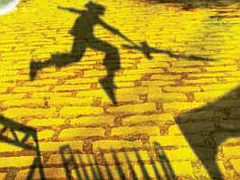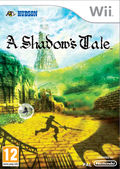You can trust VideoGamer. Our team of gaming experts spend hours testing and reviewing the latest games, to ensure you're reading the most comprehensive guide possible. Rest assured, all imagery and advice is unique and original. Check out how we test and review games here
On the roof of a tower that flirts with the clouds, there’s a boy hanging ominously in the air. Restrained by two stone pillars, it appears that the boy has been imprisoned. What did he do to deserve such punishment? A mysterious man appears, not uttering a word that could answer this question. His features are hidden under the darkness of his cloak, but he makes no effort to conceal the huge sword at his side, which appears to have been made from large metallic jigsaw pieces. Despite not looking like it could cut an onion in half, he swings it aggressively at the defenceless child. As predicted, the sword fails to do any visible damage, but instead cleaves the boy’s shadow clean from his body. The cloaked man grabs this severed shadow, and hurls it off the top of the tower, the body left precisely where it was, hanging ominously in the air.
This is where A Shadow’s Tale begins – not on top of the tower with the boy, but at the bottom with his shadow. Although the shadow has no memory of what happened, he knows that he must ascend the tower, and reclaim his body; kind of like what Peter Pan had to do, albeit in reverse. The quest takes the form of a platform/puzzle game, with the twist being that you’re playing as a shadow, and thus can only walk along platforms that are also made of shadows. The real world has very little meaning to a silhouette, but that’s not to say it can’t be interacted with…
Enter Spangle, a fairy that curiously appears at the start of the adventure (another nod to Peter Pan, perhaps?). Spangle is the shadow’s only link to the physical world, and in turn the player’s link to the game world. Pointing the Wii Remote at the screen will move Spangle about, and pressing B will allow her to interact with certain objects. Often you’ll need to rotate bits of machinery or swivel walkways in order to cast the right shadows to proceed. The platforming starts off fairly tame; jumping from one moving platform to another is pretty archaic by 2010 standards, but it isn’t long before light is introduced as a mechanic and the difficulty ramps up.
One puzzle might have you swinging a lantern with the Wii-mote, which extends certain shadows – making a previously impossible jump achievable. Another might have you sliding a lamp along the bottom of the screen, which allows you to choose where the shadows are cast, and how the subsequent environment will look. This light and shadow puzzling is fairly unique and gives rise to some nifty little graphical touches. For example, if the wall your shadow is cast on disappears, it’ll be cast on the next nearest surface, meaning your character can be seen as a tiny black silhouette way in the background of the level. Perspective is used in fascinating ways too, with your shadow running across surfaces that, without shadows to use as platforms, would be impossible to traverse at angles that would be unfeasible in reality.
In order to complete a level, you’ll need to collect three ‘monitor eyes’, a mysterious item that opens a shadow gate at the end of each level. This gives rise to one of my first problems with the game; often I’d find myself at a shadow gate with only two of the required items, forced to backtrack the whole level to find the last one. There’s nothing to tell you if you’ve missed an eye, and you never know how long the level’s going to be. Backtracking becomes an alarmingly frequent task, completely ruining the flow of each level. That said, revisiting previous areas is encouraged, to an extent, with another collectible in the form of memories.
Your health is governed by a weight meter (apparently shadows have mass), which can be extended by collecting these aforementioned memories dotted about each level. Each memory offers a little insight into the area of the level you’re in, and increases your maximum health by a few grams. Of course you can’t have a health bar without enemies. Not far into the game, you’ll come across a sword; a rusty old relic of a weapon that would be useless in a real fight. Its shadow, however, is more than capable of slaying the (shadows of) spiders, squids and other nasties that litter the halls of the tower. There’s also a rudimentary levelling system in place, and by collecting enough blue orbs from the shady carcasses of dead enemies, you’ll level up. The increases to your attack and defence are slight, though, and the system as a whole feels redundant.
At certain points during a level, you’ll stumble into a shadow corridor; a separate dimension where the laws of physics no longer hold true. Here, you’ll be able to rotate the level to reach previously inaccessible areas, but be careful: rotate the wrong way and you could find yourself squashed into a wall, lost in a dark limbo for all eternity. These sections of the game are really quite interesting, puzzle-wise, and were clearly an opportunity for the developers to go crazy with the shadow mechanics. The gameplay is turned on its head again later on in the game, with light gates that allow the shadow to enter the real world, changing the gameplay quite drastically. The puzzles are, on the whole, well orchestrated, but the game lacks something that ties the experience together.
Graphically, A Shadow’s Tale borrows a lot from Ico. The soft colour palette, strange architecture and hazy grain layered over the screen; it all creates an atmosphere reminiscent of Team Ico’s 2001 masterpiece. The minimalist music and lack of dialogue contribute to the effect too, but ultimately the game fails to pull it off with the same degree of successfully. The misty film is too thick, the colour saturation is overdone, and at times the game can look quite unsightly. One might make the argument that it’s just a Wii game, and as such you can’t expect much, but I’m not complaining about graphical prowess, I’m complaining about the unattractive art direction.
A Shadow’s Tale tries too hard to be subtle and artsy; qualities that Ico pulled off so effortlessly. It’s endearing to an extent, but the experience as a whole is marred by poor visuals, uninspiring level design and dated platforming. It’s a shame because some of the shadow effects are brilliant, and the use of light in puzzles is really quite innovative. Unfortunately though, A Shadow’s Tale doesn’t have the aesthetic credentials to back up its unique mechanics, which is ultimately the game’s biggest shortcoming. It’s certainly not a bad game, but with so many great games on the way in run up to Christmas, it’ll have a hard time stepping out of the shadows.

/https://oimg.videogamer.com/images/b7b8/the_tower_of_shadow_158.jpg)






